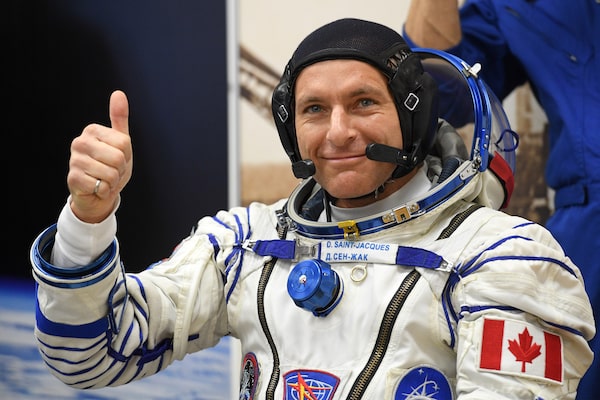
David Saint-Jacques of the Canadian Space Agency in Kazakhstan on Dec. 3, 2018.KIRILL KUDRYAVTSEV/AFP/Getty Images
Over the course of his career, David Saint-Jacques has been an engineer, astrophysicist and physician. Now, Canada’s multi-skilled astronaut aboard the International Space Station is preparing to add a new role to his résumé: cable guy.
If all goes as planned, Dr. Saint-Jacques and U.S. astronaut Anne McClain will emerge from the station’s airlock on Monday morning for a six-to-seven hour maintenance job. They will be clambering over modules, opening up compartments and wrestling with an assortment of cables as they work to bolster the orbiting laboratory’s power systems and WiFi capabilities.
In the process, Dr. Saint-Jacques will become the fourth Canadian to walk in space and the first to do so in nearly a dozen years.
“It’s spectacular that David is going to get to do one,” said Dave Williams, a retired astronaut who holds the record for Canadian spacewalks with three performed during his final mission in August, 2007.
In those days, Dr. Williams said, the space station was in construction and spacewalks were planned long in advance, allowing astronauts to “overtrain” for the tasks they would be doing outside the station while whipping around the globe at 27,000 kilometres an hour.
Today, as crew activities on the station have shifted from construction to maintenance, training for spacewalks has evolved from a focus on specific tasks to preparing for a more generic, all-purpose activity.
Dr. Saint-Jacques has been trained to perform extravehicular activities (EVAs) as needed, but it was not until after he launched last December that he learned he would have a chance to put that part of his training to use during his six-month stint in orbit.
“There’s a heightened perception of your role as an operator on behalf of the whole planet,” Dr. Saint-Jacques told The Globe and Mail last year when describing training for a spacewalk.
Dr. Saint-Jacques is set to venture outside the station as part of a series of three EVAs aimed at restoring ailing batteries and other tasks on the station.
The first took place on March 22 with a line up featuring Ms. McClain and flight engineer Nick Hague. The second, which was to be the first spacewalk in history conducted by two women, became a news item when Ms. McClain, a lieutenant colonel in the U.S. Army, opted against doing the EVA in a large size spacesuit as originally planned. Her crew mate, Christina Koch, used the one medium suit available on the station for her first spacewalk, together with Mr. Hague, leaving Ms. McClain to partner with Dr. Saint-Jacques for Monday’s EVA.
The action is expected to begin around Monday at 6:30 a.m. ET when the two don their suits. Ms. McClain will emerge first at about 8 a.m., followed by Dr. Saint-Jacques. To avoid their tether cables getting tangled, the two will follow different routes to their worksite atop the U.S. laboratory module known as Destiny.
Dr. Williams said during his spacewalks he learned to orient himself so that Earth was above his head rather than below his feet, to lessen the visual sensation of falling toward the planet. “Quite frankly, the view can be scary,” he said.
Dr. Williams added that, with so much to take in, it can be a challenge for novice spacewalkers to maintain the focus they need to complete their tasks in the allotted time. Another challenge is getting used to moving around in a spacesuit without colliding with the structures around the station or with another astronaut.
This is mainly because astronauts are primarily trained for EVAs in an underwater facility. The water provides resistance which makes it hard to gain momentum but easy to stop. In the airless vacuum outside the space station, it’s just the opposite: Movements are easy to start and not so easy to stop.
“It takes a while to learn how to be graceful in space,” Dr. Williams said.
Coincidentally, during his last spacewalk in 2007, Dr. Williams worked with the same micrometeoroid shields on the Destiny module that Dr. Saint-Jacques and Ms. McClain will have to open and then close after installing a new cable. The task was not an easy one, he said, adding that he sent Dr. Saint-Jacques an e-mail with some advice on what to expect.
Cables can become a challenge when they are disconnected and assume whatever configuration they were in before they were installed.
“It’s like wrestling with an anaconda,” Dr. Williams said. “Cables have memory.”